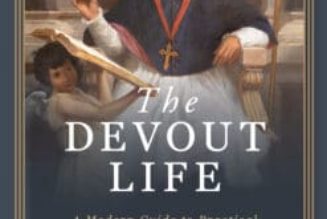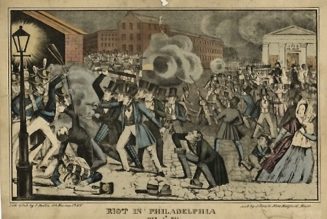
“The pastoral duty of the Magisterium is aimed at seeing to it that the People of God abides in the truth that liberates. To fulfill this service, Christ endowed the Church’s shepherds with the charism of infallibility in matters of faith and morals.” (CCC 890)
As I have been reading Bishop Athanasius Schneider’s book, Christus Vincit, I am struck by the similarities between his experiences and mine.
Although we come from very different parts of the world, we were born just a couple of months apart in 1961, at the end of an era in the Church. All through the sixties, changes kept coming. I remember receiving my First Holy Communion in 1968, kneeling at the altar rail of Our Lady of Perpetual Help in Glenview, Illinois. Our family relocated to Jacksonville, Florida, the next year, and shortly thereafter the marble rail at the church we attended was removed, leaving large holes in the floor and wall.
I don’t remember having religious objections at the time, but even as a boy of nine I wondered why beautiful marble would simply be discarded. My mother had a marble table I admired, and I was always told to be careful around it because it was special. Seeing a marble altar rail ripped out and stacked behind the church for disposal looked to me to be an act of vandalism and senseless destruction. Something was wrong in the Church.
Speaking with my paternal grandmother, “Nana,” also led me to think that something was wrong. She visited often and then lived with us during my teenage years. Nana was a devout, traditional Catholic and missed the old hymns, the Rosaries, the Latin, and the quiet during Mass. She was not one to directly criticize the changes — and especially not priests — but her laments made a deep impression on me because I thought her a holy woman.
In his book, Bishop Schneider likewise speaks of becoming more aware as a teen that something was wrong in the Church:
I began receiving circular letters from the Society of Saint Pius X. A neighbor sent them to our home. I always read them. In my soul I experienced a dilemma. On the one hand, I noticed that there was much truth in the letters, especially when I read about the Holy Mass and saw the liturgical celebrations portrayed in beautiful photographs. My intuition as a 16-year-old youth told me that what Archbishop Lefebvre said was substantially right. But I was in a quandary because I had a deep veneration for the pope. From one side, I saw the truth and the beauty of the Catholic faith and specifically of the Holy Mass presented by Archbishop Lefebvre, and from the other side, he was condemned by the pope. I was profoundly devoted to the pope, and so I could not understand this. It was very difficult for me. I started then to read more intensely about Vatican II (Christus Vincit, pp. 117-118).
This was my experience as well. Catholics were taught to revere their priests and bishops — and especially the Holy Father. The nuns, too, were figures commanding respect. My growing discomfort with the loss of beauty and reverence came at the hands of priests I was conditioned to revere. The nuns said and did confusing things as well. They seemed to discard their habits as if they were rags. When I questioned a couple of them as to why, they talked about “the bad old days” symbolized by those habits and how they had newfound liberation. The most astonishing thing to me was that the nuns, once seemingly everywhere when I was a child, were now were almost nowhere to be found in my teenage years. They really broke the hearts of the faithful, as did the priests who left in droves.
I also was in my mid to late teens when I began receiving literature from the Society of St. Pius X (SSPX). It was unsolicited and came to me probably because I was a church musician and often searched traditional publishing houses looking for musical gems from the past. Like Bishop Schneider, I marveled at the beauty of those SSPX publications, and much of what I read made a lot of sense. I, too, was torn.
When I spoke of this literature to the parish priests, I was often rebuked and warned that it was disobedient to read such material. It was clear to me that I could not speak to them of the substance of the issues; it was rare that I found a priest who did more than shut me down immediately. The few priests who were sympathetic to me would listen, but they had few helpful answers. They merely said that the Church had changed now and that besides, things weren’t so great in the old days either. Most of them seemed quite surprised that a young man, a teenager, lamented the loss of the older ways.
My feelings were similar to those described by Bishop Schneider: an awareness that something was wrong, that the beauty of traditions had been lost; but also an obligation, by that very sense of tradition, to revere and obey the leaders who had undertaken these revolutionary changes.
There arose a position in those years that sought to downplay this dilemma. Basically, the position was that there could be nothing wrong with the text of the Second Vatical Council, only with those who misinterpreted it or highjacked it for their own purposes. Archbishop Schneider speaks to that period well:
Implicitly I considered every word of the Council and the pope as infallible, or at least without error. It was for me a kind of unconscious and total “infallibilization” of the Council. … I was uncomfortable when there were critics, and I did not like to follow or study the critics because I was afraid of going in a direction that would be unfaithful to the Church and to my devotion to the pope. … Nowadays I realize that I “turned off” my reason. However, such an attitude is not healthy and contradicts the tradition of the Church… (Ibid, pp. 118-119).
I, too, found solace in the documents of the Council. They weren’t nearly as radical as some had suggested. Though there were greater permissions for the use of vernacular and other forms of music, there were also many nods to the use of Latin and to Gregorian Chant. Lumen Gentium had many great passages, including ones that identified Mary as the Mother of the Church and called the lay faithful to holiness.
As an American, I did not view the document on religious liberty as radical. However, I have since come to recognize that it largely broke with the Church’s earlier teachings and that such a break must be directly addressed, rather than shrugged off. Bishop Schneider does an admirable job of setting forth those issues in his book.
Like Bishop Schneider, I have had to refine my understanding of infallibility, taking care to understand this gift as the Church herself understands it. Though I realize that infallibility is a negative charism that prevents the Church from binding the faithful to error, I was often too expansive in my assignment of practically inerrant authority to every document of a council or utterance of a pope. Too often I stifled my use of reason rather than using it, faithfully, to “abide in the truth that liberates” (CCC 890).
Bishop Schneider elaborates on his development in this area:
I entered the Congregation of the Holy Cross, the Canons Regular, who were — and still are — very faithful to the doctrine of the Church, with a very reverent manner of celebrating the liturgy, even the new Mass, but ad orientem, with Communion kneeling and on the tongue. I remember experiencing a kind of blind defense of everything that was said by the Council, which seemed sometimes to require mental acrobatics and a “squaring of the circle.”
…This kind of extreme ultramontanism, an unhealthy papal-centrism, had already been present for several generations in Catholics. I was also educated in this mentality. But criticism has always been present and allowed within Church tradition, since it is the truth and faithfulness to divine revelation and tradition that we should seek, which in itself implies the use of reason and rationality and avoiding erroneous acrobatics (Ibid. p. 119).
I, too, have had to retool, especially in the current papacy. During my adult life I have been under the care of Popes John Paul II and Benedict XVI. While I was a few times alarmed by events at Assisi conferences or by some particular papal utterance, I generally felt they had a firm hand on the tiller and were steering us toward orthodoxy and a recapturing of what had been lost. It was quite easy to be papal-centric then.
Frankly, we turned the popes into celebrities who traveled around the world holding huge outdoor Masses and addressing massive throngs. Perhaps this was unhealthy, even if it made for great publicity and served the cause of evangelization, because it encouraged triumphalism and a focus on one man as the whole Church.
The papacy of Pope Francis has sobered many of us, especially those who were content to place complete confidence in every utterance of every contemporary pope. Though we had a vague idea that there had been difficult papacies in the past, it was easy to dismiss such long ago problems.
My first reaction to some of Pope Francis’ stranger statements was to “popesplain” — “Surely, he did not mean that literally,” or, “We have to understand the context in which he was speaking.” But as time went on, it grew more and more difficult. As Bishop Schneider put it, it became an exercise in mental acrobatics.
Thus, I too struggle with the current situation. My instinct is always to love the Pope, to support his vision and be of one heart and mind with him. But with all the controversies, scandals and weaponized ambiguity of the past five years, I find myself reeling. I seek a new balance that shows respect for the Holy Father while also respecting my obligation to teach the faithful exactly what the Church teaches, from the depths of our Catholic tradition, with clarity and love.
So many of the faithful reach out to me, confused and disheartened by the mixed messages that come not only from Rome but from cardinals, bishops, priests, Catholic media and the Catholic “blogosphere.” I cannot leave the faithful confused about the teachings of our faith. I cannot retreat into endless silence.
My response to this current dilemma is to steep my messages in Scripture and the Catechism, to avoid focusing or making direct attacks on fellow clerics (including the Pope), and to keep teaching what we have always taught. I try to critique, not attack, where necessary, and I always go back to the sources.
I pray that I will always be willing to suffer for the truth of the Gospel and the treasure of faith and doctrine handed down. Meanwhile, I seek always to preserve unity with my own bishop and to love and pray for the Holy Father. Ultimately, I must stand before the Lord on my last day. I pray that I get the balance right and that I please Almighty God. It’s a harder needle to thread these days, but prudence and courage demand it.
Bishop Athanasius Schneider and I were born continents apart, but not worlds apart. I have found much to value in his book, and I am grateful that he is willing to share his story. It helps me to know my own story.
Pray for priests and clergy of every rank.









